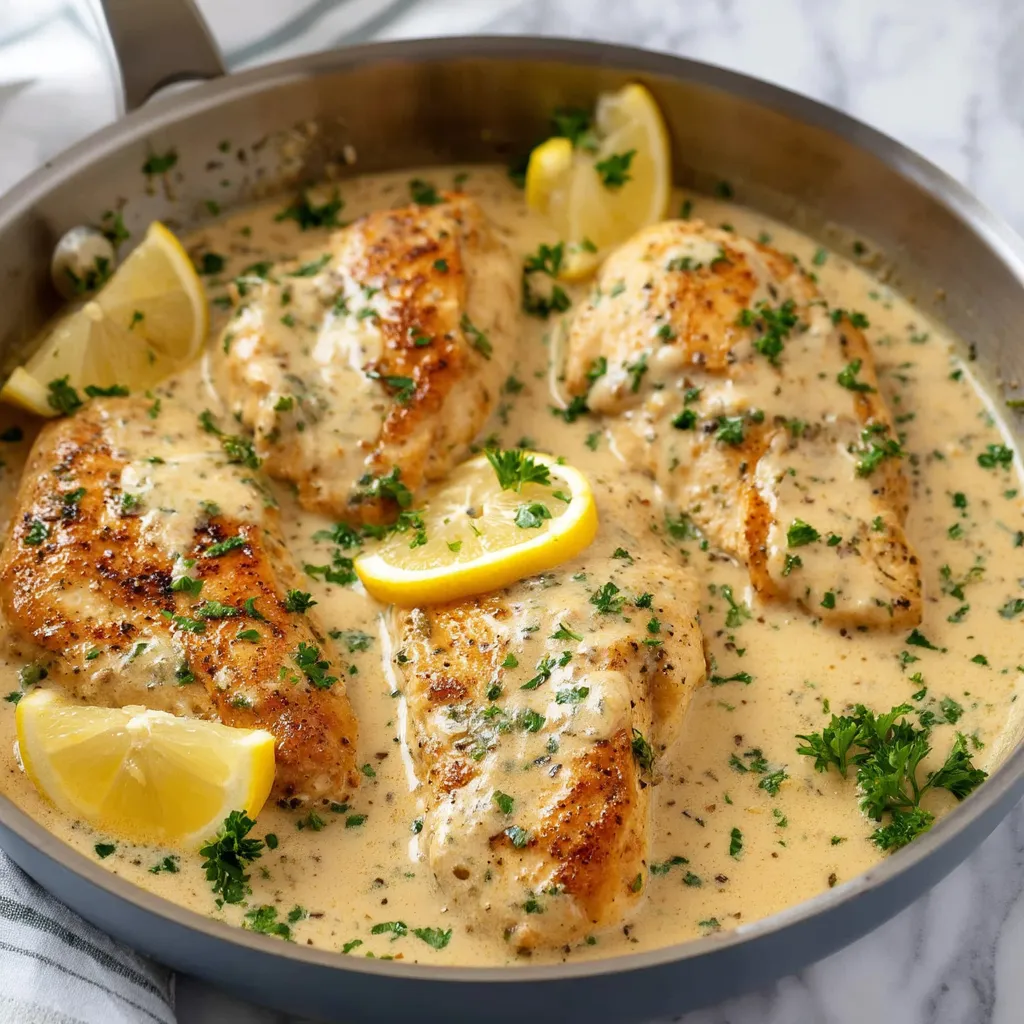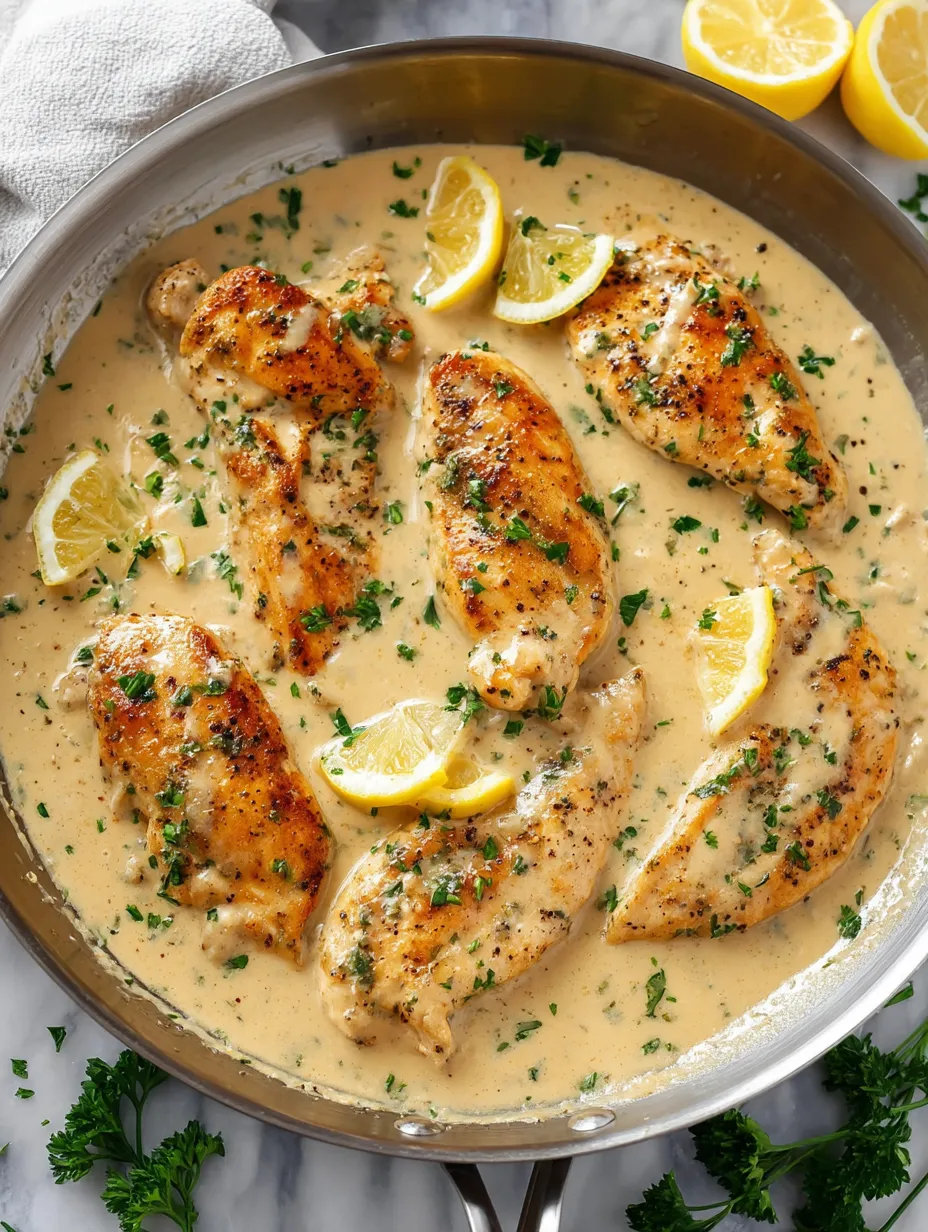 Pin it
Pin it
This garlic parmesan chicken is a restaurant-quality dish you can easily make at home, featuring tender chicken breasts smothered in a rich, creamy sauce infused with fresh garlic, white wine, and Parmesan cheese. The sauce is truly the star here, velvety and bursting with savory flavors that will have everyone asking for seconds.
I first made this dish for my husband on our anniversary when we couldn't get a reservation at our favorite Italian restaurant. He declared it better than anything we could have ordered out, and it's become our special occasion go-to ever since.
Ingredients
- Chicken breasts: Large boneless skinless breasts that you'll pound thin for even, quick cooking and maximum tenderness
- Heavy cream: Creates the silky texture in the sauce without being overly rich or heavy
- White wine: Adds acidity and depth that elevates this from a basic cream sauce to something special
- Fresh garlic: The backbone of flavor here use fresh cloves for the most aromatic punch
- Parmesan cheese: Opt for freshly grated from a block for superior melting and authentic flavor
- Chicken broth: Forms the base of the sauce provides depth and savory notes
- Seasonings: The combination of herbs and spices creates layers of flavor without overwhelming the dish
- Butter and flour: Creates a roux that thickens the sauce to the perfect consistency
- Lemon juice: Adds brightness that cuts through the richness and brings all flavors into balance
Step-by-Step Instructions
- Prep the sauce:
- Combine chicken broth, heavy cream, Worcestershire, mustard powder, honey, bouillon, and seasonings in a measuring cup with a spout. This allows for easy pouring later and ensures all flavors are evenly distributed throughout the sauce.
- Prepare the chicken:
- Slice each chicken breast horizontally to create thinner cutlets. Cover with plastic wrap and pound to an even half-inch thickness. This step is crucial for even cooking and tender results. Season generously with salt, pepper, and parsley on both sides to build flavor from the start.
- Sear the chicken:
- Heat olive oil in a large skillet until shimmering. Cook chicken in batches to avoid overcrowding, which ensures proper browning. Aim for 4-5 minutes per side until deeply golden. This caramelization adds tremendous flavor to both the chicken and the eventual sauce.
- Create the flavor base:
- Turn off heat before adding wine for safety, then set to medium. Scrape the bottom of the pan thoroughly to release all the browned bits. These contain concentrated flavor that will elevate your sauce. Reduce the wine until it has lost its raw alcohol smell and add garlic, being careful not to burn it.
- Build the sauce:
- Add butter and flour, stirring constantly to create a smooth paste. Cook this mixture for the full recommended time to eliminate any raw flour taste. Add the prepared sauce mixture gradually, stirring between additions to prevent lumps from forming. Allow the sauce to simmer until it begins to thicken noticeably.
- Finish with cheese and brightness:
- Reduce heat before adding the Parmesan to prevent separation. Sprinkle cheese in slowly while stirring to ensure it melts smoothly into the sauce. The fresh lemon juice added at the end brightens all the flavors and cuts through the richness perfectly.
- Return chicken and serve:
- Nestle the chicken back into the sauce, spooning the mixture over the top to coat completely. The final simmer allows the chicken to absorb the flavors while the sauce reaches the ideal consistency. Garnish with fresh parsley for color and a touch of herbaceous flavor.
 Pin it
Pin it
You Must Know
I discovered by accident that letting the sauce rest for about 5 minutes before serving allows the flavors to meld even more deeply. My family now insists on this brief waiting period every time I make this dish, gathering around the kitchen island with anticipation as the aromas fill our home.
Making Perfect Substitutions
If you prefer not to cook with alcohol, additional chicken broth makes an excellent substitute for the wine, though you might want to add an extra squeeze of lemon juice to compensate for the missing acidity. For a lighter version, half and half can replace heavy cream with minimal difference in flavor, though the sauce will be slightly less rich. Those avoiding gluten can use cornstarch instead of flour simply mix 1.5 tablespoons with cold water before stirring into the sauce.
 Pin it
Pin it
Serving Beyond The Basics
While mashed potatoes are my favorite accompaniment for soaking up every drop of this delicious sauce, the versatility of this dish extends far beyond. Try serving it over buttered egg noodles for a stroganoff-like experience, or alongside roasted asparagus and wild rice for an elegant dinner party presentation. For a low-carb option, roasted spaghetti squash creates a delicious base that mimics pasta while adding subtle sweetness.
Storage And Reheating Tips
Store leftovers in an airtight container in the refrigerator for up to three days. When reheating, add a splash of chicken broth to revitalize the sauce as it tends to thicken considerably when chilled. For best results, reheat gently on the stovetop rather than the microwave, which can cause the sauce to separate. If freezing, cool completely before transferring to freezer-safe containers and freeze for up to three months. Thaw overnight in the refrigerator before reheating.
Frequently Asked Questions
- → What type of Parmesan cheese should I use?
Grate fresh Parmesan cheese from a block for the best flavor and texture. Avoid pre-shredded as it might not melt properly.
- → Can I substitute the white wine?
Yes, you can use chicken broth as a substitute for white wine if you prefer not to cook with alcohol.
- → How do I ensure the sauce thickens properly?
Let the sauce simmer and reduce, stirring continuously. Adding the Parmesan cheese gradually helps achieve the right thickness.
- → What sides pair well with this dish?
Mashed potatoes, roasted vegetables, or a light side salad are great pairings for Garlic Parmesan Chicken.
- → How do I store leftovers?
Store leftovers in an airtight container in the refrigerator for up to 3 days. Reheat gently on the stove or in the microwave.
